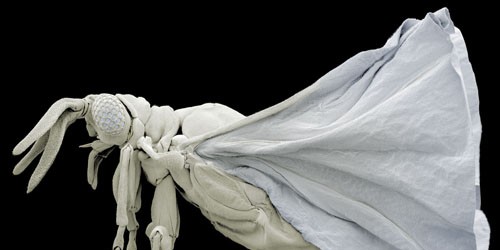
Enigma of Twisted-Wing Parasites resolved
Scientists have long been mystified by the insect group called twisted-wing parasite. It includes over 500 species and although it has been known for almost 200 years, till now it could not be linked to any super-ordinate group of insects. A team of scientists that worked under the direction of Prof. Bernhard Misof and Dr. Oliver Niehuis from the Koenig Museum in Bonn, and the team of Prof. Erich Bornberg-Bauer from the Institute of Evolution and Biodiversity of Münster University have, for the first time ever, sequenced the entire genetic code – the genome – of a twisted-wing parasite, thus enabling the scientists to classify these insects as a sister group of the beetle. The findings of their research have been published in the online edition of the journal "Current Biology".
"Entomologists are somewhat accustomed to the peculiar appearance and behaviour of their research subjects. Twisted-wing parasites, however, have particularly unusual characteristics. Therefore, some researchers have jokingly referred to them as 'insects from outer space' because they were not able to assign them to a concrete position in the evolutionary tree," Erich Bornberg-Bauer explains. The twisted-wing parasites – scientifically known as Strepsiptera – are usually no larger than a few millimetres. While the adult male has wings, the female has not. These insects spend at least part of their lives as parasites in the bodies of other insects, such as wasps or silverfish. The females of most sub-species even spend their whole life in the bodies of their hosts. Adult males only live a few hours which they exclusively dedicate to finding a female to mate.
Up until now scientists could not agree on whether the Strepsiptera are closely related to beetles or to flies – or neither of these groups. Strepsiptera undergo a gradual development from larva to adult insect. After a number of larval stages they pupate. The adult insect then emerges from the chrysalis. This so-called holometabolous development can also be found for example in butterflies, beetles and flies. Twisted-wing parasites, however, display a few additional features of another type of development – the hemimetabolous development in which no pupal stage exists. This is why some scientists believed Strepsiptera to be the missing link between these two groups of insects.
By comparing the Strepsiptera genome with eleven already known insect genomes together with newly analysed genetic material of the beetle, the research team has now disclosed that the Strepsiptera are a sister group of the beetle – both groups share one common ancestor. This shows that Strepsiptera are not the missing link between hemimetabolous and holometabolous insects. The characteristics of Strepsiptera and the holometabolous insects rather developed independently from each other. The Strepsiptera have reactivated a developmental cycle that also takes effect in hemimetabolous insects. According to the scientists, the holometabolous developmental cycle is therefore not necessarily as rigid as was once assumed. Bernard Misof stresses that, with this discovery, one of the last enigmas of the genealogical tree of the insects – the largest and most diverse group of animals – has been resolved.
Translation by master students of the translation course of Joanna Becker, English Department
